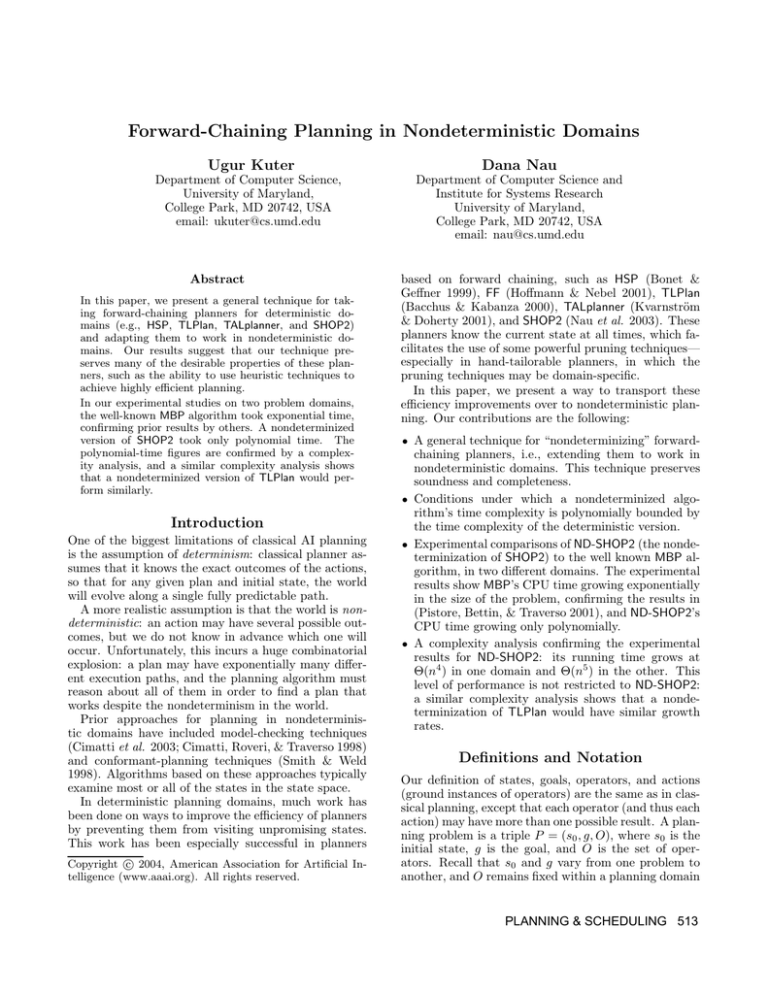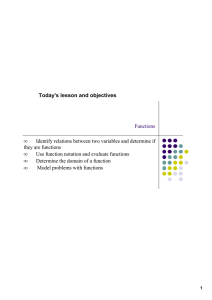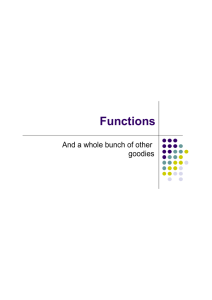
Forward-Chaining Planning in Nondeterministic Domains
Ugur Kuter
Dana Nau
Department of Computer Science,
University of Maryland,
College Park, MD 20742, USA
email: ukuter@cs.umd.edu
Department of Computer Science and
Institute for Systems Research
University of Maryland,
College Park, MD 20742, USA
email: nau@cs.umd.edu
Abstract
In this paper, we present a general technique for taking forward-chaining planners for deterministic domains (e.g., HSP, TLPlan, TALplanner, and SHOP2)
and adapting them to work in nondeterministic domains. Our results suggest that our technique preserves many of the desirable properties of these planners, such as the ability to use heuristic techniques to
achieve highly efficient planning.
In our experimental studies on two problem domains,
the well-known MBP algorithm took exponential time,
confirming prior results by others. A nondeterminized
version of SHOP2 took only polynomial time. The
polynomial-time figures are confirmed by a complexity analysis, and a similar complexity analysis shows
that a nondeterminized version of TLPlan would perform similarly.
Introduction
One of the biggest limitations of classical AI planning
is the assumption of determinism: classical planner assumes that it knows the exact outcomes of the actions,
so that for any given plan and initial state, the world
will evolve along a single fully predictable path.
A more realistic assumption is that the world is nondeterministic: an action may have several possible outcomes, but we do not know in advance which one will
occur. Unfortunately, this incurs a huge combinatorial
explosion: a plan may have exponentially many different execution paths, and the planning algorithm must
reason about all of them in order to find a plan that
works despite the nondeterminism in the world.
Prior approaches for planning in nondeterministic domains have included model-checking techniques
(Cimatti et al. 2003; Cimatti, Roveri, & Traverso 1998)
and conformant-planning techniques (Smith & Weld
1998). Algorithms based on these approaches typically
examine most or all of the states in the state space.
In deterministic planning domains, much work has
been done on ways to improve the efficiency of planners
by preventing them from visiting unpromising states.
This work has been especially successful in planners
c 2004, American Association for Artificial InCopyright telligence (www.aaai.org). All rights reserved.
based on forward chaining, such as HSP (Bonet &
Geffner 1999), FF (Hoffmann & Nebel 2001), TLPlan
(Bacchus & Kabanza 2000), TALplanner (Kvarnström
& Doherty 2001), and SHOP2 (Nau et al. 2003). These
planners know the current state at all times, which facilitates the use of some powerful pruning techniques—
especially in hand-tailorable planners, in which the
pruning techniques may be domain-specific.
In this paper, we present a way to transport these
efficiency improvements over to nondeterministic planning. Our contributions are the following:
• A general technique for “nondeterminizing” forward-
chaining planners, i.e., extending them to work in
nondeterministic domains. This technique preserves
soundness and completeness.
• Conditions under which a nondeterminized algorithm’s time complexity is polynomially bounded by
the time complexity of the deterministic version.
• Experimental comparisons of ND-SHOP2 (the nondeterminization of SHOP2) to the well known MBP algorithm, in two different domains. The experimental
results show MBP’s CPU time growing exponentially
in the size of the problem, confirming the results in
(Pistore, Bettin, & Traverso 2001), and ND-SHOP2’s
CPU time growing only polynomially.
• A complexity analysis confirming the experimental
results for ND-SHOP2: its running time grows at
Θ(n4 ) in one domain and Θ(n5 ) in the other. This
level of performance is not restricted to ND-SHOP2:
a similar complexity analysis shows that a nondeterminization of TLPlan would have similar growth
rates.
Definitions and Notation
Our definition of states, goals, operators, and actions
(ground instances of operators) are the same as in classical planning, except that each operator (and thus each
action) may have more than one possible result. A planning problem is a triple P = (s0 , g, O), where s0 is the
initial state, g is the goal, and O is the set of operators. Recall that s0 and g vary from one problem to
another, and O remains fixed within a planning domain
PLANNING & SCHEDULING 513
but varies from one domain to another.
We also use most of the same definitions used in
nondeterministic planning domains. γ(s, a), the statetransition function induced by the set of operators O,
gives the set of all possible states that may result from
applying the action a to the state s, with γ(s, a) = ∅
if a is not applicable to s. The planning domain is
deterministic iff |γ(s, a)| ≤ 1 ∀s∀a. A policy is a set
π = {(si , ai )}ki=1 , where k ≥ 0 is the size of the policy. The set of states in π is Sπ = {s | (s, a) ∈ π}.
We require that for any state s, there is at most one
action a such that (s, a) ∈ π. The execution structure
for π is a directed graph Σπ whose nodes are all of the
states that can be reached by executing actions in π,
and whose edges represent the possible state transitions
caused by actions in π. If there is a path in Σπ from
s1 to s2 , then we say that s1 is a π-ancestor of s2 and
s2 is a π-descendant of s1 . We use the usual definitions
(Cimatti et al. 2003) of weak, strong, and strong-cyclic
solutions for planning problems.
Researchers have often defined nondeterministic versions of well-known deterministic problems; we formalize this notion as follows. A planning problem
P 0 = (S0 , g, O0 ) is a nondeterministic version of a deterministic planning problem P = (s0 , g, O) if s0 ∈ S0 and
O is identical to O 0 except that each operator in O 0 may
have additional sets of effects. These additional effects
can be used to model action failures (e.g., a gripper
drops what it is holding) and exogenous events (e.g., a
road is closed).
Nondeterminizing Forward Planners
We now describe a general technique for taking forwardchaining planners for deterministic planning domains,
and nondeterminizing them, i.e., translating them into
planners that find strong-cyclic solutions in nondeterministic domains. A policy π is a strong-cyclic solution
if every (finite or infinite) path in Σπ can be extended to
a finite execution path that reaches to a goal state. We
have also developed planners that produce weak and
strong solutions; see (Kuter & Nau 2004) for details.
The basis of our approach is an abstract planning
procedure FCP for deterministic domains, and a corresponding procedure ND-FCP for nondeterministic domains. Both are described below. If a planner Λ can
be described as an instance of FCP, then, ND-Λ, the
corresponding instance of ND-FCP, will be the strongcyclic nondeterminization of Λ. Using this technique,
we have written strong-cyclic nondeterminizations of
TLPlan (Bacchus & Kabanza 2000), SHOP2 (Nau et
al. 2003), TALplanner (Kvarnström & Doherty 2001),
and several other forward planners (see (Kuter & Nau
2004)).
As shown in Figure 1, FCP starts with an initial state
s0 , and explores other states by successively choosing
and applying planning operators until it reaches a state
that satisfies the goal formula g. The action-selection
function α(s) is used to prune the search space. It returns zero or more actions, which we will call the ac-
514
PLANNING & SCHEDULING
Procedure FCP(s0 , g, O, α);
π ← ∅; s ← s0
loop
if s satisfies g then return(π)
A ← {(s, a) | a is a ground instance of an operator
in O, a is applicable to s, and a ∈ α(s)}
if A = ∅ then return(f ailure)
nondeterministically choose (s, a) ∈ A
π ← π ∪ {(s, a)}
s ← γ(s, a)
Figure 1: An abstract forward-chaining planning procedure for deterministic planning domains.
Procedure ND-FCP(S0 , g, O0 , α0 )
π ← ∅; S ← S0 ; solved ← ∅
loop
if S = ∅ then return(π)
select a state s ∈ S and remove it from S
if s satisfies g then insert s into solved
else if s 6∈ Sπ then
A ← {(s, a) | a is a ground instance of an operator in O0 , a is applicable to s, and
a ∈ α0 (s)}
if A = ∅ then return(f ailure)
nondeterministically choose (s, a) ∈ A
π ← π ∪ {(s, a)}
S ← S ∪ γ(s, a)
else if s has no π-descendants in (S ∪ solved) \ Sπ
then return(f ailure)
Figure 2: Nondeterminization of FCP. The underlines indicate how the coding from FCP is embedded
in ND-FCP.
tions that satisfy α(s). Rather than trying all of the
actions applicable to s, FCP only tries the ones that are
applicable and satisfy α.
For example, in SHOP2, the search is controlled by
a set of methods that decompose tasks into subtasks,
and α(s) is the set of all actions a applicable to s such
that a can be produced by applying methods to the
current task network. In TLPlan (Bacchus & Kabanza
2000), the search is controlled by a formula φ written
in a modal logic called Linear Temporal Logic (LTL).
For each state s, α(s) is the set of all actions a applicable to s such that the successor state γ(s, a) satisfies a
progressed formula, P rogress(s, φ).
Figure 2 shows ND-FCP, the strong-cyclic nondeterminization of FCP. Like FCP, ND-FCP plans forward
from S0 , but the success criterion is more complicated.
In FCP, a plan π is a solution if its final state satisfies
the goal condition g. In order for a policy in ND-FCP
to be a solution, every state in π’s execution structure
must have at least one π-descendant that satisfies the
goal (a solved state in the pseudocode).
ND-FCP’s action-selection function is analogous to
FCP’s, and the action-selection function for a deterministic domain can generally be adapted to work in nondeterministic versions of the domain. As an example,
recall that for TLPlan, the action-selection function α(s)
for a planning domain D returns all actions applicable
to s such that γ(s, a) satisfies P rogress(s, φ), where φ
is a search-control formula. If D 0 is a nondeterministic
version of D, then one possible action-selection function for ND-TLPlan is α0 (s) = {all actions a such that
at least one state in γ(s, a) satisfies P rogress(s, φ)}.
This trivial adaptation of α works correctly, but usually ND-TLPlan will perform more efficiently if we write
an action-selection function that returns only some of
the actions in α0 (s).
Theoretical Properties
It is not hard to show that FCP and ND-FCP are both
sound (i.e., they do not return any plan that is not
a solution), and that they are conditionally complete
in the sense that they can find every solution whose
actions satisfy the action-selection function.
We now establish an upper bound on the time complexity of a nondeterminized planning algorithm in a
strongly connected planning domain. A planning domain is strongly connected if for any two states s and
s0 , there exists a sequence of actions that reaches to
s0 when executed in s. Such domains are not hard to
find: some well-known examples from previous planning
competitions include Blocks-World, Logistics, DriverLog,
ZenoTravel, Depot, and Rover. Any nondeterminization
of such a domain will also be strongly connected.
Theorem 1 Let Λ be an instance of FCP. Suppose
Λ finds solution plans in time O(ρ(|π|)) in stronglyconnected planning domains, where |π| is the size of
the solution plan and ρ is a monotonic function. Then
ND-Λ finds solution policies in time O(ρ(|Σπ0 |)), where
|Σπ0 | is the size of execution structure for the solution
policy returned by ND-Λ.
Corollary 1 Under the conditions of Theorem 1, if the
number of possible successors of each state is bounded
by a constant, then ND-Λ finds solution policies in time
O(ρ(|π 0 |)), where |π 0 | is the size of the solution policy.
Note that every path in Σπ0 can be extended to a
finite execution path that reaches to a goal state in a
strongly-connected domain. In domains that are not
strongly connected, however, Σπ0 may contain states
that have no π 0 -descendants that satisfy the goals. We
call such states as the dead-end states of Σπ0 .
The following complexity result holds even in planning domains that are not strongly connected:
Theorem 2 Let Λ be an instance of FCP, and suppose
that Λ’s running time is O(ρ(|π|), where |π| is the size
of the solution plan returned by Λ, and ρ is a monotonic
function. Then ND-Λ finds solution policies in average
0
time O(ρ(n) + xdn
y )), where n = |Σπ | is the size of the
execution structure for the solution policy π 0 returned by
ND-Λ, x the maximum number of state-action pairs that
are added to any policy after ND-Λ visits a dead-end
state, y is the maximum number of actions applicable
to any state, and in every state s, 0 ≤ d ≤ y is the
maximum number of actions applicable to s that lead to
a dead-end state.
Corollary 2 Under the conditions of Theorem 2, if the
number of possible successors of each state is bounded by
a constant, then ND-Λ finds solutions in average time
0
|
0
O(ρ(|π 0 |)+ xd|π
y )), where |π | is the size of the solution.
Experiments and Complexity Analysis
In order to perform an empirical evaluation of our theoretical results, we implemented ND-SHOP2, the nondeterminized version of SHOP2. We compared its performance and scalability for reachability goals with MBP
(Bertoli et al. 2001), a well-known planning system
for nondeterministic domains that is based on symbolic
model checking techniques. In our comparisons, we
used MBP’s Local Search algorithm for finding strongcyclic plans.1 All of our experiments were run on an
AMD Duron 900Mhz laptop computer running Linux
RedHat 7.2 with 256MB memory.
Our first experimental domains was the Robot Navigation domain that was used for experimental evaluation of MBP in (Pistore, Bettin, & Traverso 2001).
This domain is a variant of a similar domain described
in (Kabanza, Barbeau, & St-Denis 1997). It consists
of a building with 8 rooms connected by 7 doors. In
the building, there is a robot and there are a number of
packages in various rooms. The robot is responsible for
delivering packages from their initial locations to their
final locations by opening and closing doors, moving
between rooms, and picking up and putting down the
packages. The robot can hold at most one package at
any time. To add nondeterminism, the domain also involves a “kid” that can close any of the open doors that
are designated initially as “kid-doors.”
We compared ND-SHOP2 and MBP with the same
set of experimental parameters as in (Pistore, Bettin, &
Traverso 2001): the number of packages n ranged from
1 to 5, and the number of kid-doors k ranged from 0
to 7. For each combination of n and k, we generated
20 random problems, ran the planners on the problems,
and averaged the CPU time for each planner.2
Figure 3 shows the results for k = 7 and n = 1, . . . , 5;
this illustrates the behavior of the algorithms as the size
of the domain increases.
Our experimental results confirm the ones in (Pistore, Bettin, & Traverso 2001): in both their experiments and ours, MBP’s CPU time grows exponentially
(the logarithm of the data grows linearly) in the size
1
We also tried using MBP’s Global Search algorithm, but
the Local Search algorithm ran faster.
2
As in (Pistore, Bettin, & Traverso 2001), the CPU time
for MBP’s includes both its preprocessing and search times.
Omitting the preprocessing times would not have significantly affected the results: they were never more than a few
seconds, and usually below one second.
PLANNING & SCHEDULING 515
Figure 3: Average running times of ND-SHOP2 and
MBP on Robot-Navigation problems, as a function of
the number of packages. The number of kid-doors in
the domain is fixed to 7.
Figure 4: Average running times of ND-SHOP2 and
MBP on Robot-Navigation problems, as a function of
the number of kid-doors. The number of packages in
the domain is fixed to 5.
of the problem. In contrast, the data for ND-SHOP2
show its CPU time growing polynomially, at only about
Θ(n4 ). Using the results in the previous section, we
have confirmed that this is the correct growth rate for
ND-SHOP2 in this domain.
To illustrate the scalability of the algorithms as the
amount of nondeterminism increases, Figure 4 shows
the results for n = 5 and k = 1, . . . , 7. In each case,
MBP takes one to two orders of magnitude more time
than ND-SHOP2. The closest runtimes occurred at k =
4, where MBP is about 15 times slower than ND-SHOP2.
The reason for ND-SHOP2’s fast performance relative
to MBP is as follows. In the representation language for
the Robot Navigation domain, a policy can say things
along the lines of “if we are at door number 3 and it is
open, then go through it,” rather than having to give
explicitly all of the exponentially many states of the
world in which we’re at door number 3 and the door is
open. Because of this, problems in the robot-navigation
domain have strong-cyclic solutions of linear size, and
these are the solutions that ND-SHOP2 finds. Although
MBP represents policies in a similar way, it apparently
does not exploit this representation well enough to produce policies of polynomial size.
We also compared ND-SHOP2 and MBP on a nondeterministic version of the classical Blocks World domain.
We introduced nondeterminism by allowing the operators to have three kinds of outcomes: (1) their traditional effects, (2) an operator may fail to change the
state at all, and (3) an operator may fail by dropping
the block onto the table.
Figure 5 shows the results of our experiments. Like
before, each data point is the average of 20 random
problems. For MBP, there are no data points for n > 8
because it was unable to solve any problems within the
alloted time (30 minutes per problem). The logarithm
of MBP’s CPU time is linear; thus on this problem, like
the other one, MBP takes exponential time.
Curve-fitting on ND-SHOP2’s running time shows it
growing at only about Θ(n5 ), and a complexity analysis
confirms this polynomial behaviour. The reasons are
similar to the ones earlier: each time an operator puts
a block in the wrong place, ND-SHOP2’s methods tell
it to pick it up and try again. As a result, ND-SHOP2
is guaranteed to produce a policy of size O(n) where
n is the number of blocks. In contrast, MBP produces
exponential-size policies that tell what to do in most of
the states of the world.
It would also be possible to write nondeterministic
versions of the blocks world with more complicated
kinds of nondeterminism: for example, an operator
could drop a block not just onto the table, but onto
any clear block. We have not yet tested this case experimentally, but our complexity analysis shows that
such an experimental study would yield results similar to the above. ND-SHOP2 would take polynomial
time and space, although the space would this time be
quadratic rather than linear (it would immediately pick
up the fallen block again, but in the worst case there
would be O(n) different places to pick up this block
from). MBP would take exponential time in the size of
the problem, for the same reasons as before.
Although we have not implemented our pseudocode
for ND-TLPlan, the nondeterminization of TLPlan, we
have analyzed its complexity on the planning domains
discussed in this section. The analysis shows that with
appropriate control rules, it would perform similarly to
ND-SHOP2 in these domains. The details of our complexity analyses can be found in (Kuter & Nau 2004).
516
PLANNING & SCHEDULING
Related Work
One of the first approaches for planning in nondeterministic domains is the idea of conditional planning,
which uses an extended form of STRIPS operators to
have mutually-exclusive and conditional effects (Pryor
& Collins 1996; Peot & Smith 1992). This approach
Figure 5: Average running times of ND-SHOP2 and
MBP in the nondeterministic Blocks-World domain, as
a function of the number of blocks.
does not scale up for complex planning domains.
The best-known approach for planning in nondeterministic domains is based on symbolic model-checking
techniques (Cimatti et al. 2003; Cimatti, Roveri,
& Traverso 1998; Daniele, Traverso, & Vardi 1999;
Pistore, Bettin, & Traverso 2001). These works establish the notions of weak, strong, and strong-cyclic
solution and algorithms based on symbolic techniques
for finding such solution to nondeterministic planning
problems. MBP (Bertoli et al. 2001) is an implementation of the ideas presented in these works.
Planning based on Markov Decision Processes
(MDPs) (Boutilier, Dean, & Hanks 1999) also has actions with more than one possible outcome, but models the possible outcomes using probabilities and utility functions, and formulates the planning problem as
an optimization problem. In MDPs, a policy is a total
function from states to actions, whereas model-checking
approaches allow a policy to be partial. For problems that can be solved either by MDPs or by modelchecking-based planners, the latter have been empirically shown to be more efficient (Bonet & Geffner 2001).
Satisfiability and planning-graph based approaches
have been extended to do planning in nondeterministic domains. To the best of our knowledge, the nondeterministic satisfiability-based planners (Castellini,
Giunchiglia, & Tacchella 2003; Ferraris & Giunchiglia
2000)are limited to conformant planning, where the
planner has nondeterministic actions and no observability. The planning-graph based techniques can address conformant planning and a limited form of partialobservabilitiy (Smith & Weld 1998; Weld, Anderson, &
Smith 1998).
In deterministic planning domains, a key property of
forward-chaining planners is that they know the current state at all times. This allows them to incorporate very powerful pruning techniques— particularly in
hand-tailorable planners, in which the pruning tech-
niques can be domain-specific. The domain-specific
knowledge can be encoded into a planner in different
forms. For example, HSP (Bonet & Geffner 1999) uses
a heuristic function that allows the planner to choose
the best successor state that can be reached by applying
an action to the current state. Another heuristic-based
planner, FF (Hoffmann & Nebel 2001), computes the
heuristic values over the states by running a variation
of the GraphPlan algorithm (Blum & Furst 1997) on a
relaxed instance of the input planning problems. TLPlan
(Bacchus & Kabanza 2000) and TALplanner (Kvarnström & Doherty 2001) use different kinds of temporallogic formulas. In SHOP2 (Nau et al. 2003), domainspecific knowledge is encoded as task networks which
SHOP2 decomposes recursively until it reaches a task
network in which all tasks can be directly executed.
Two planning approaches that can exploit search control in nondeterministic domains are RTDP (Bonet &
Geffner 2000), which is based on greedy-search techniques, and SIMPLAN (Kabanza, Barbeau, & St-Denis
1997). SIMPLAN was developed for planning with reactive agents in nondeterministic domains for temporallyextended goals. We did not consider SIMPLAN for our
experiments since to the best of our knowledge it cannot
produce strong-cyclic solutions.
Conclusions
During the past few years, some very efficient forwardchaining planners have been developed for planning in
deterministic domains; there are many cases in which
these planners can run in polynomial time. The goal
of this paper has been to translate these advances in
efficiency over to nondeterministic planning domains.
We have presented a general technique for taking
forward-chaining planners for deterministic domains
(e.g., HSP, TLPlan, TALplanner, and SHOP2), and nondeterminizing them to work in nondeterministic domains. The nondeterminization technique preserves
soundness and completeness.
There are significant classes of nondeterministic planning problems in which the number of possible states
is exponential but there are solutions whose execution
structures have polynomial size. Our theoretical results
suggest that in such domains, nondeterminizations of
efficient deterministic planners may be able to do well.
The theoretical results are confirmed by our experiments and complexity analyses on two different problem
domains. One of of these (Robot Navigation) has been
used in several previous studies of planning in nondeterministic environments. In both problem domains, our
experimental data show MBP’s running time growing
exponentially and ND-SHOP2’s growing only polynomially. A complexity analysis for ND-SHOP2 confirms the
latter result, and a complexity analysis for ND-TLPlan
shows that it would perform similarly to ND-SHOP2 on
these problems.
In the near future, we intend to improve our implementation of ND-SHOP2: for example, its implementation of ND-FCP’s reachability tests is rather naive and
PLANNING & SCHEDULING 517
can be done much more efficiently. We intend to test
our approach on additional planning domains, extend it
to deal with temporally extended goals, and perhaps to
implement nondeterminizations of additional planners.
In the longer term, we hope to extend the theory of
nondeterministic planning domains to encompass several of the kinds of problem features that can be handled by planners such as SHOP2 and TLPlan, such as
numeric computations, axiomatic inference, and calls to
external information sources and software packages. We
also hope to develop a technique for translating planners for deterministic domains into planners for probabilistic domains.
Acknowledgments
This work was supported in part by the following
grants, contracts, and awards: Air Force Research
Laboratory F30602-00-2-0505, Army Research Laboratory DAAL0197K0135, and Naval Research Laboratory
N00173021G005. The opinions expressed in this paper
are those of authors and do not necessarily reflect the
opinions of the funders.
References
Bacchus, F., and Kabanza, F. 2000. Using Temporal Logics to Express Search Control Knowledge for
Planning. Artificial Intelligence 116(1-2):123–191.
Bertoli, P.; Cimatti, A.; Pistore, M.; Roveri, M.; and
Traverso, P. 2001. MBP: A Model Based Planner.
In Proceedings of IJCAI Workshop on Planning under
Uncertainty and Incomplete Information, 93–97.
Blum, A. L., and Furst, M. L. 1997. Fast Planning
Through Planning Graph Analysis. Artificial Intelligence 90(1-2):281–300.
Bonet, B., and Geffner, H. 1999. Planning as Heuristic
Search: New Results. In Proceedings of the European
Conference on Planning (ECP), 360–372. Durham,
UK: Springer-Verlag.
Bonet, B., and Geffner, H. 2000. Planning with Incomplete Information as Heuristic Search in Belief Space.
In Chien, S.; Kambhampati, S.; and Knoblock, C.,
eds., Proceedings of the International Conference on
AI Planning Systems (AIPS), 52–61. Breckenridge,
CO: AAAI Press.
Bonet, B., and Geffner, H. 2001. GPT: A tool for
planning with uncertainty and partial information. In
Proceedings of the International Joint Conference on
Artificial Intelligence (IJCAI), 82–87. Seattle, WA:
Morgan Kaufmann.
Boutilier, C.; Dean, T. L.; and Hanks, S. 1999.
Decision-Theoretic Planning: Structural Assumptions
and Computational Leverage. Journal of Artificial Intelligence Research 11:1–94.
Castellini, C.; Giunchiglia, E.; and Tacchella, A. 2003.
SAT-Based Planning in Complex Domains: Concurrency, Constraints and Nondeterminism. Artificial Intelligence 147(1–2):85–117. To appear.
518
PLANNING & SCHEDULING
Cimatti, A.; Pistore, M.; Roveri, M.; and Traverso,
P. 2003. Weak, Strong, and Strong Cyclic Planning
via Symbolic Model Checking. Artificial Intelligence
147(1–2):35–84.
Cimatti, A.; Roveri, M.; and Traverso, P. 1998. Strong
Planning in Non-Deterministic Domains via Model
Checking. In Proceedings of the International Conference on AI Planning Systems (AIPS), 36–43. Pittsburgh, PA: AAAI Press.
Daniele, M.; Traverso, P.; and Vardi, M. 1999. Strong
Cyclic Planning Revisited. In Proceedings of the European Conference on Planning (ECP), 35–48. Durham,
UK: Springer.
Ferraris, P., and Giunchiglia, E. 2000. Planning
as Satisfiability in Nondeterministic Domains. In
AAAI/IAAI Proceedings, 748–753. Menlo Park, CA:
AAAI Press.
Hoffmann, J., and Nebel, B. 2001. The FF Planning System: Fast Plan Generation Through Heuristic Search. Journal of Artificial Intelligence Research
14:253–302.
Kabanza, F.; Barbeau, M.; and St-Denis, R. 1997.
Planning Control Rules for Reactive Agents. Artificial
Intelligence 95(1):67–113.
Kuter, U., and Nau, D. 2004. Using Forward-Chaining
Planning for Generating Weak, Strong, and StrongCyclic Solutions in Nondeterministic Domains. Technical Report CS-TR-4580, Dept. of Computer Science,
University of Maryland.
Kvarnström, J., and Doherty, P. 2001. TALplanner: A
Temporal Logic-based Forward-chaining Planner. Annals of Mathematics and Articial Intelligence 30:119–
169.
Nau, D.; Au, T.-C.; Ilghami, O.; Kuter, U.; Murdock,
W.; Wu, D.; and Yaman, F. 2003. SHOP2: An HTN
Planning System. Journal of Artificial Intelligence Research 20:379–404.
Peot, M., and Smith, D. 1992. Conditional Nonlinear
Planning. In Proceedings of the International Conference on AI Planning Systems (AIPS), 189–197. College Park, MD: AAAI Press.
Pistore, M.; Bettin, R.; and Traverso, P. 2001. Symbolic Techniques for Planning with Extended Goals in
Nondeterministic Domains. In Proceedings of the European Conference on Planning (ECP). Toledo, ES:
Springer Verlag.
Pryor, L., and Collins, G. 1996. Planning for Contingency: A Decision-based Approach. Journal of Artificial Intelligence Research 4:81–120.
Smith, D. E., and Weld, D. S. 1998. Conformant
Graphplan. In AAAI/IAAI Proceedings, 889–896.
Menlo Park, CA: AAAI Press.
Weld, D. S.; Anderson, C. R.; and Smith, D. E.
1998. Extending Graphplan to Handle Uncertainty
and Sensing Actions. In AAAI/IAAI Proceedings,
897–904. Menlo Park, CA: AAAI Press.





